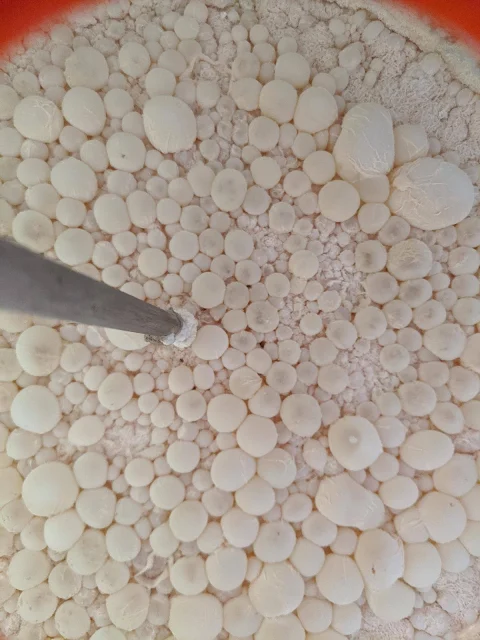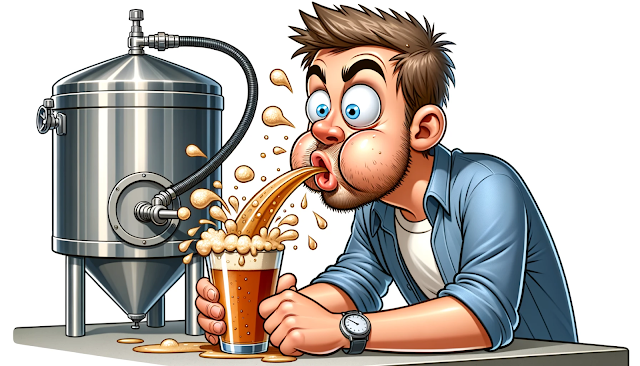There's a super simple way to determine if your beer brew is contaminated
Ready for hot tip?
You taste it.
If it tastes like the scummiest thing you've ever put in your mouth, it's infected.
If the sensation mirrors that of the foulest thing you've ever tasted, it's tainted. If it induces nausea, it's tainted. A sulfur bomb that smells of rotten eggs aroma? Infected. An explosion reminiscent of a rigorously shaken bottle upon opening? Likely contaminated due to over-carbonation from rogue yeast or bacteria. Don't confuse this with the aftermath of adding excessive sugar during priming, known as a beer bomb.
Remember, if you're questioning whether your beer is contaminated, it probably is.
Before bottling, consider visually inspecting your beer. Keep an eye out for a 'pellicle' or yeast raft at the wort's surface, signaling a congregation of microbes. Though not every infection results in this formation, its presence is a clear sign:
Discovering such an infection is undeniably disheartening. You've not only lost time and resources, but your hard-earned efforts have gone down the drain.
Yet, this misadventure is an invaluable lesson in the essence of brewing:
CLEANLINESS & SANITIZATION ARE PARAMOUNT
Having learned my lesson, it's been years since I encountered an infected batch. Cleaning may seem laborious, but if you crave a perfect pint, it's non-negotiable.
Root Causes of Infection
The primary culprit? Lack of cleanliness. Any remnants offer bacteria a haven, escalating the risk of infection. Every piece of equipment, from fermenters to mash tuns, requires meticulous cleaning. Hot to boiling water paired with a reliable cleaning agent, like Powdered Brewery Wash, will serve you well.
Then comes sanitization. Sodium percarbonate is a top choice. It's not only effective but also conveniently found in everyday laundry soak.
For bottling or kegging, the same rules apply. Clean, then sanitize. A nifty trick for bottles is to rinse them thoroughly, then cycle them through a dishwasher on its hottest setting. This annihilates any lingering microbes. Store them in a pristine container, and on bottling day, a brief soak in sodium percarbonate ensures they're ready.
If only a few bottles from a batch taste off, the problem likely lies with individual bottles, not the entire batch.
Addressing the Rotten Egg Smell Mystery
The signature rotten egg aroma can be a telltale sign of contamination. Yet, it doesn't always spell disaster. Some yeast strains naturally exude this scent. Bottle-conditioned beers, if opened prematurely, can also exhibit this aroma. Over time, as yeast continues its work, the odor dissipates.
In areas with water high in sulphate, like Burton-on-Trent, England, this scent is inherent – the famed 'Burton Snatch'. But if bacteria are the cause, the aroma, combined with an unpleasant taste, confirms your beer's unfortunate fate.
For wine or cider enthusiasts, fruits' natural yeasts can be disruptive. Many cider makers employ Campden tablets to neutralize wild yeast, substituting with yeast strains better aligned with their desired product.
Yet, this misadventure is an invaluable lesson in the essence of brewing:
CLEANLINESS & SANITIZATION ARE PARAMOUNT
Having learned my lesson, it's been years since I encountered an infected batch. Cleaning may seem laborious, but if you crave a perfect pint, it's non-negotiable.
Root Causes of Infection
The primary culprit? Lack of cleanliness. Any remnants offer bacteria a haven, escalating the risk of infection. Every piece of equipment, from fermenters to mash tuns, requires meticulous cleaning. Hot to boiling water paired with a reliable cleaning agent, like Powdered Brewery Wash, will serve you well.
Then comes sanitization. Sodium percarbonate is a top choice. It's not only effective but also conveniently found in everyday laundry soak.
For bottling or kegging, the same rules apply. Clean, then sanitize. A nifty trick for bottles is to rinse them thoroughly, then cycle them through a dishwasher on its hottest setting. This annihilates any lingering microbes. Store them in a pristine container, and on bottling day, a brief soak in sodium percarbonate ensures they're ready.
If only a few bottles from a batch taste off, the problem likely lies with individual bottles, not the entire batch.
 |
| This "mega Pellicle' was from a beer brew that was found to be infected. |
Addressing the Rotten Egg Smell Mystery
The signature rotten egg aroma can be a telltale sign of contamination. Yet, it doesn't always spell disaster. Some yeast strains naturally exude this scent. Bottle-conditioned beers, if opened prematurely, can also exhibit this aroma. Over time, as yeast continues its work, the odor dissipates.
In areas with water high in sulphate, like Burton-on-Trent, England, this scent is inherent – the famed 'Burton Snatch'. But if bacteria are the cause, the aroma, combined with an unpleasant taste, confirms your beer's unfortunate fate.
For wine or cider enthusiasts, fruits' natural yeasts can be disruptive. Many cider makers employ Campden tablets to neutralize wild yeast, substituting with yeast strains better aligned with their desired product.





